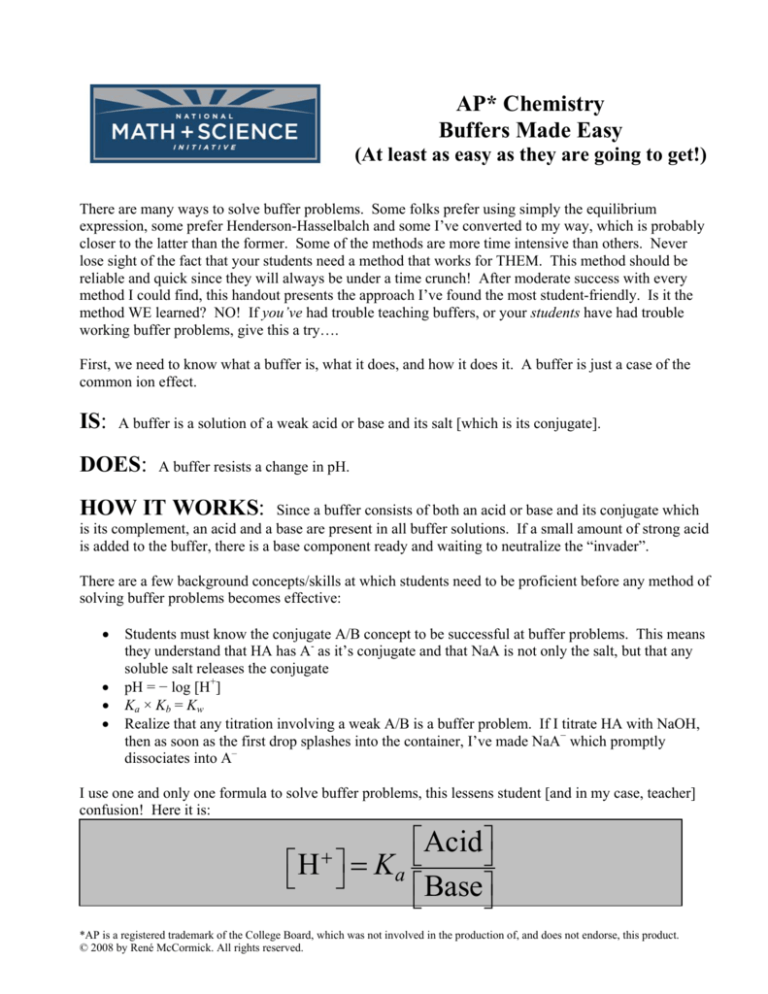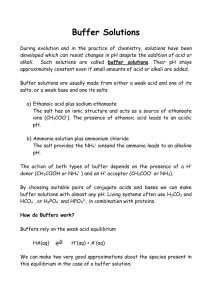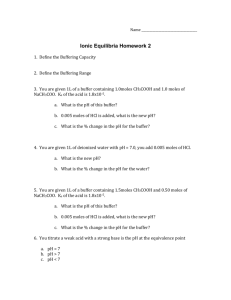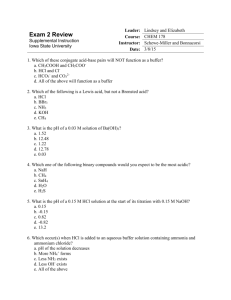
AP* Chemistry
Buffers Made Easy
(At least as easy as they are going to get!)
There are many ways to solve buffer problems. Some folks prefer using simply the equilibrium
expression, some prefer Henderson-Hasselbalch and some I’ve converted to my way, which is probably
closer to the latter than the former. Some of the methods are more time intensive than others. Never
lose sight of the fact that your students need a method that works for THEM. This method should be
reliable and quick since they will always be under a time crunch! After moderate success with every
method I could find, this handout presents the approach I’ve found the most student-friendly. Is it the
method WE learned? NO! If you’ve had trouble teaching buffers, or your students have had trouble
working buffer problems, give this a try….
First, we need to know what a buffer is, what it does, and how it does it. A buffer is just a case of the
common ion effect.
IS:
A buffer is a solution of a weak acid or base and its salt [which is its conjugate].
DOES:
A buffer resists a change in pH.
HOW IT WORKS:
Since a buffer consists of both an acid or base and its conjugate which
is its complement, an acid and a base are present in all buffer solutions. If a small amount of strong acid
is added to the buffer, there is a base component ready and waiting to neutralize the “invader”.
There are a few background concepts/skills at which students need to be proficient before any method of
solving buffer problems becomes effective:
•
•
•
•
Students must know the conjugate A/B concept to be successful at buffer problems. This means
they understand that HA has A- as it’s conjugate and that NaA is not only the salt, but that any
soluble salt releases the conjugate
pH = − log [H+]
Ka × Kb = Kw
Realize that any titration involving a weak A/B is a buffer problem. If I titrate HA with NaOH,
then as soon as the first drop splashes into the container, I’ve made NaA− which promptly
dissociates into A–
I use one and only one formula to solve buffer problems, this lessens student [and in my case, teacher]
confusion! Here it is:
⎡H
⎣
⎡ Acid ⎤
⎣
⎦
=
K
a
⎦
⎡ Base⎤
⎣
⎦
+⎤
*AP is a registered trademark of the College Board, which was not involved in the production of, and does not endorse, this product.
© 2008 by René McCormick. All rights reserved.
If acid is added to the buffer, simply add acid to the numerator AND subtract the same quantity from the
base since it was self-sacrificing and neutralized the acid. If base is added, simply add the base to the
denominator and subtract from the numerator. Add or subtract in moles NOT molarity! Moles = M ×V
When equal concentrations (or moles) of Acid and Base are present [which occurs at the ½ equivalence
point of a titration] the ratio of acid to base equals ONE and therefore, the pH = pKa. IF you are asked
to construct a buffer of a specific pH and given a table of Ka’s, choose a Ka with an exponent close to
the desired pH and use equal concentrations of the acid and base.
Let’s try it! Here’s a common calculate the pH of a buffer before and after an “invader” is added.
Convert to moles when doing the adding and subtracting! The Ka of formic acid is 1.8 × 10–4
Exercise 1
Calculate the pH of 0.500 L of a buffer solution composed of 0.50 M formic acid and 0.70 M sodium
formate before and after adding 10.0 mL of 1.00 M HCl.
PREPARING BUFFER SOLUTIONS:
Use 0.10 M to 1.0 M solutions of reagents & choose an acid whose Ka is near the [H3O+] concentration
we want. The pKa should be as close to the pH desired as possible. Adjust the ratio of weak A/B and its
salt to fine tune the pH.
Exercise 2
Using an acetic acid\sodium acetate buffer solution, what ratio of acid to conjugate base will you need to
maintain the pH at 5.00? Explain how you would make up such a solution.
It is the relative # of moles of acid/CB or base/CA that is important since they are in the same solution
and share the same solution volume.
2
Buffers Made Easy
This allows companies to make concentrated versions of buffer and let the customer dilute--this will not
affect the # of moles present--just the dilution of those moles.
What if you’re given a Kb?
Exercise 3
A buffered solution contains 0.25 M NH3 ( Kb = 1.8 × 10–5) and 0.40 M NH4Cl.
a) Calculate the pH of this solution.
b) Calculate the pH when 0.10 mol of gaseous HCl is added to 1.0 L of the buffered solution.
Exercise 4
A chemist needs a solution buffered at pH 4.30 and can choose from the following list of acids and their
soluble salt:
a. chloroacetic acid Ka = 1.35 × 10–3
b. propanoic acid
Ka = 1.3 × 10–5
c. benzoic acid
Ka = 6.4 × 10–5
d. hypochlorus acid Ka = 3.5 × 10–8
Calculate the ratio of A/B required for each system to yield a pH of 4.30. Which system works best?
3
Buffers Made Easy
ACID-BASE TITRATION CURVES
Only when the acid AND base are both strong is the pH at the equivalence point 7. Any other
conditions and you get to do a nasty equilibrium problem. It’s really a stoichiometry problem with a
limiting reactant. The “excess” is responsible for the pH
Weak acid + strong base ) eq. pt. > pH 7
Strong acid + weak base ) eq. pt. < pH 7
There is a distinction between the equivalence point and the end point. The end point is when the
indicator changes color. If you’ve made a careful choice, the equivalence point, when the number of
moles of acid = number of moles of base, will be achieved at the same time.
Exercise 5
For the titration of 50.0 mL of 0.200 M HNO3 with 0.100 M NaOH calculate the pH of the solution at
the following selected points of the titration:
a) NO NaOH has been added:
b) 10.0 mL of NaOH has been added:
c) 20.0 mL (total as opposed to additional) of NaOH has been added:
d) 50.0 mL (total) of NaOH has been added:
e) 100.0 mL (total) of NaOH has been added:
f) 200.0 mL (total) of NaOH has been added:
4
Buffers Made Easy
FIVE POINTS OF INTEREST ALONG A TITRATION CURVE for weak acids/bases:
1. The pH before the titration begins. Treat as usual, the acid or base in the flask determines the
pH. If weak, a RICE table is in order.
2. The pH on the way to the equivalence point. You are in the “land of buffer” as soon as the
first drop from the buret makes a splash and reacts to form the salt. Whatever is in the
⎡ Acid ⎤
⎦ to solve for the hydrogen ion
⎡ Base⎤
⎣
⎦
burette is the “added” part. Use ⎡ H + ⎤ = Ka ⎣
⎣
⎦
concentration and subsequently the pH. Either the acid or the base [whichever is in the
burette] starts at ZERO.
⎡ Acid ⎤
⎦ on the
3. The pH at the midpoint of the titration (½ equivalence point): ⎡ H + ⎤ = Ka ⎣
⎣
⎦
⎡ Base ⎤
⎣
⎦
+
way to the equivalence point as explained above; once the midpoint is reached, [H ] = Ka
since ½ of the acid or base has been neutralized, AND the resulting solution in the beaker is
composed of the half that remains AND the salt. That means the A/B term is a big tall ONE
so, it follows that pH = pKa.
4. The pH at the equivalence point.—you are simply calculating the pH of the salt, all the acid
or base is now neutralized [to salt + water!]. Write the hydrolysis reaction as the “R” of your
RICE table. [Examples follow the fifth point of interest…]
5. The pH beyond the equivalence point—it’s stoichiometry again with a limiting reactant.
Calculate the molarity of the EXCESS and solve for either pH directly (excess H+) or pOH
(excess OH−) and subtract it from 14 to arrive at pH. Be sure to track the total volume when
calculating the molarity!
LEARNING TO WRITE SALT HYDROLYSIS REACTIONS
Recall that when quantities of acid and base react, a neutralization reaction takes place and the
products of such a reaction are salt and water. The trouble is that not all salts are neutral.
However, reasoning through the pH of a salt is easy as is writing the subsequent hydrolysis
reaction. Ponder the following points:
•
•
•
•
•
“Hydrolysis” translates into “water splitting” but the salt is also split. The rest of this will
be much easier if you think of H2O as HOH and as a reactant. Essentially, a hydrolysis
reaction is the reverse of a neutralization reaction and is written in net ionic form for all
soluble salts.
IF a strong base is reacted with a weak acid, “Strong wins!” and the salt is basic, thus
OH– forms as a product.
IF a strong acid is reacted with a weak base, “Strong wins!” and the salt is acidic, thus
H+ forms as a product.
The “Strong” portion of the acid or base is source of the “Spectator” ion.
The remaining ion (or neutral molecule) is the reactant that reacts with the water.
5
Buffers Made Easy
Example 1 Write the hydrolysis reaction for the salt, NaCN.
Explanation: First, recognize NaCN as a salt if that information is not given—the polyatomic ion
is a dead give away! Next, ask yourself which acid reacted with which base to generate the salt
in the first place?
Which base? NaOH. Which acid? HCN.
Now, ask yourself: Is the base strong or weak? NaOH, strong. Is the acid strong or weak? HCN,
weak. “Strong wins!”, so it is a basic salt, AND “Strong is also the Spectator.” So, sodium ion
is not in the net ionic hydrolysis equation, leaving CN– as the reacting species. Ah, you are
ready to write the hydrolysis reaction.
Start the same way every time you try to write a hydrolysis reaction…draw the arrow in the
center of your answer space!
→
It’s a hydrolysis reaction, water is a reactant and splits into H+ and OH–, so write it as HOH until
you get the hang of this process. Your reaction looks like this so far:
+
HOH →
Recap what you now know: NaCN is a basic salt. Since it is basic, OH– is a product. Your
reaction improves…
+
HOH →
OH–
More knowledge: Na+ is a spectator (since “Strong, Spectator”—it’s an alliteration, get it?
Strong and Spectator both start with an “S”.) leaving CN– as the other reactant. Your reaction
improves yet again…
CN–
+
HOH →
OH–
Now, think…think…think. IF HOH released OH– as a product, then H+ is left to react with the
negative cyanide ion. Your final improvement to the reaction finishes it off…
CN–
+
HOH →
OH– + HCN
Why is this such a big deal? A hydrolysis reaction is what you must plop into your RICE table
to solve for the pH (or pOH) of an acid-base titration where either participant is weak.
BECAUSE, at the equivalence point moles acid = moles base = moles salt formed. Just be sure
and calculate the molarity of the salt by tracking the total volume before putting its concentration
into the rice table.
6
Buffers Made Easy
Example 2 Write the hydrolysis reactions for the following salts:
a)
b)
c)
d)
KNO2
NH4NO3
CH3NH3Cl
NaClO2
a) Basic salt
NO2–
+
HOH →
OH– + HNO2
b) Acidic salt
NH4+
+
HOH →
H+
c) Acidic salt
e) Basic salt
CH3NH3+ +
ClO2–
+
HOH → H+
HOH →
+ NH4OH
+ CH3NH3OH
OH– + HClO2
Exercise 6
Hydrogen cyanide gas (HCN), a powerful respiratory inhibitor, is highly toxic. It is a very weak
acid (Ka = 6.2 × 10–10) when dissolved in water. If a 50.0 mL sample of 0.100 M HCN is titrated
with 0.100 M NaOH, calculate the pH of the solution
a) after 8.00 mL of 0.100 M NaOH has been added.
b) at the halfway point of the titration.
c) at the equivalence point of the titration.
7
Buffers Made Easy
CHOOSING INDICATORS FOR TITRATIONS
Choose and indicator with a Ka near that of the acid you’re titrating AND whose color changes strongly at
the equivalence point. Those blasted “e” words! moles acid equal moles base at the equivalence point…the
color changes at the end point. Choose your indicator wisely, and the two coincide!
Exercise 7
Use table 15.8 to decide which indicator would be best to use in the titration of ammonia with hydrochloric
acid.
Exercise 8
Bromthymol blue has a Ka value of 1.0 × 10–7, is yellow in its HIn form and blue in its In- form. Suppose
we put a few drops of this indicator in a strongly acidic solution. If the solution is then titrated with NaOH,
at what pH will the indicator color change first be visible?
Shall we try this with some retired AP questions?
[Go to the AP Buffers Free Response Questions handout.]









